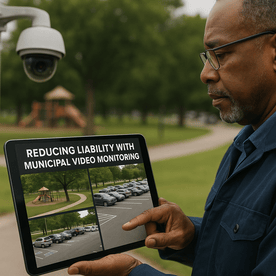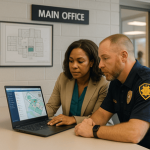
Slip-and-fall claims. Vandalism. Vehicle damage. Disputes between citizens.
If you work in city government or facilities management, you’ve likely dealt with at least one of these situations—and without proof, it’s often your word (and your budget) against theirs.
For municipalities, public spaces like parking lots and parks are high-liability zones. They’re open, unsupervised, and subject to constant foot and vehicle traffic. It only takes one incident to trigger a costly legal battle, insurance claim, or reputational hit.
That’s where modern video surveillance steps in—not just as a deterrent, but as a documented layer of protection.
In this post, we’ll explain how smart surveillance systems help municipalities reduce liability, improve response times, and support community trust—especially in city-managed outdoor spaces.
K
K
Why Parks and Parking Lots Pose a Liability Risk
Parks and parking lots may seem low-risk, but they check all the boxes for municipal liability exposure:
-
They’re public and unsupervised, often after hours
-
There’s minimal staff visibility into real-time incidents
-
Most cities rely on witness reports—which are often incomplete or biased
-
Claims often involve injuries, property damage, or misconduct—all of which are expensive to settle
A single camera in the right location can tell a different story:
-
Did the person actually trip over damaged pavement?
-
Was the vehicle already dented before entering the city lot?
-
Did the reported fight escalate before or after police were called?
With clear footage, cities can protect themselves from false claims, speed up investigations, and demonstrate due diligence.
K
K
How Smart Cameras Help Cities Mitigate Risk
Today’s surveillance systems are smarter than ever. They go beyond passive recording to offer real-time alerts, automated footage management, and mobile access.
Here’s how that helps municipalities reduce liability:
1. Video Documentation of Incidents
Whether it’s a trip-and-fall at a walking trail or a fender bender in a public lot, having clear footage provides crucial context for claims. Cities can review and share footage with police, legal teams, or insurance adjusters—without delay.
“Our parks department resolved a false injury claim in two days with video evidence. Before cameras, that would have dragged on for months,” says a city risk manager SSP worked with in South Carolina.
K
K
2. Real-Time Alerts for Suspicious Activity
Smart cameras can detect unusual motion, people entering after hours, or cars loitering in low-traffic areas. This helps prevent issues before they escalate.
-
Monitor skate parks after curfew
-
Watch for crowds forming in parking areas
-
Detect vandalism attempts on city property or statues
When paired with SSP's monitoring solutions, alerts can be sent to city staff, police dispatch, or mobile devices in real time.
K
K
3. Footage That’s Easy to Find and Share
Older systems often store footage in ways that make retrieval difficult—especially when time is short.
Modern video platforms used by SSP offer:
-
Search by date, camera, or event type
-
Cloud storage with user permissions
-
One-click export for insurance, legal, or internal documentation
This makes it easy for municipalities to act quickly when someone says, “I slipped and hurt myself near the fountain last Thursday.”
K
K
4. Discouraging False Claims
When people know cameras are rolling, they’re less likely to exaggerate or fabricate events.
Visible signage and camera placement in parking lots and parks act as deterrents for fraud, while still respecting privacy.
K
K
Where to Install Cameras in City Parks and Lots
You don’t need to blanket every tree or pole with cameras. SSP helps municipalities strategically place surveillance where liability is highest:
| Location | Why It Matters |
|---|---|
| Playground entrances | Injury disputes, child safety |
| Parking lot entry/exit points | License plate capture, hit-and-runs |
| Near pavilions and restrooms | Vandalism, altercations, late-night use |
| Skate parks and basketball courts | Fights, noise complaints, after-hours use |
| Trailheads and walking paths | Trip hazards, bike collisions, theft |
Our team evaluates sight lines, lighting, network access, and usage patterns to ensure maximum coverage and minimal blind spots.
K
K
Common Misconceptions
“A camera won’t stop someone from falling.”
True—but it gives you the evidence to prove it wasn’t negligence, which is often the bigger cost.
“We don’t have the budget for smart surveillance.”
Most modern systems are affordable, scalable, and eligible for grant funding—especially when tied to public safety or infrastructure upgrades.
“We don’t want to invade privacy.”
Cameras in public spaces like parks and lots are fully legal and widely accepted, especially when paired with visible signage and reasonable policies.
K
K
Final Thoughts
Surveillance in parks and parking lots isn’t about watching the public—it’s about protecting your staff, assets, and budget from unnecessary liability.
Whether you’re a large city or a small town, having smart, well-placed video monitoring in your public spaces can mean the difference between a months-long legal mess and a resolved claim backed by video evidence.
K
K
Ready to Reduce Risk with Smarter Surveillance?
SSP helps municipalities protect their people and property with intelligent, audit-ready video monitoring systems—customized for your city’s needs and budget.
Contact us to schedule a free site assessment or consultation.


